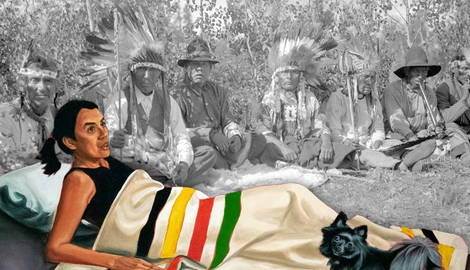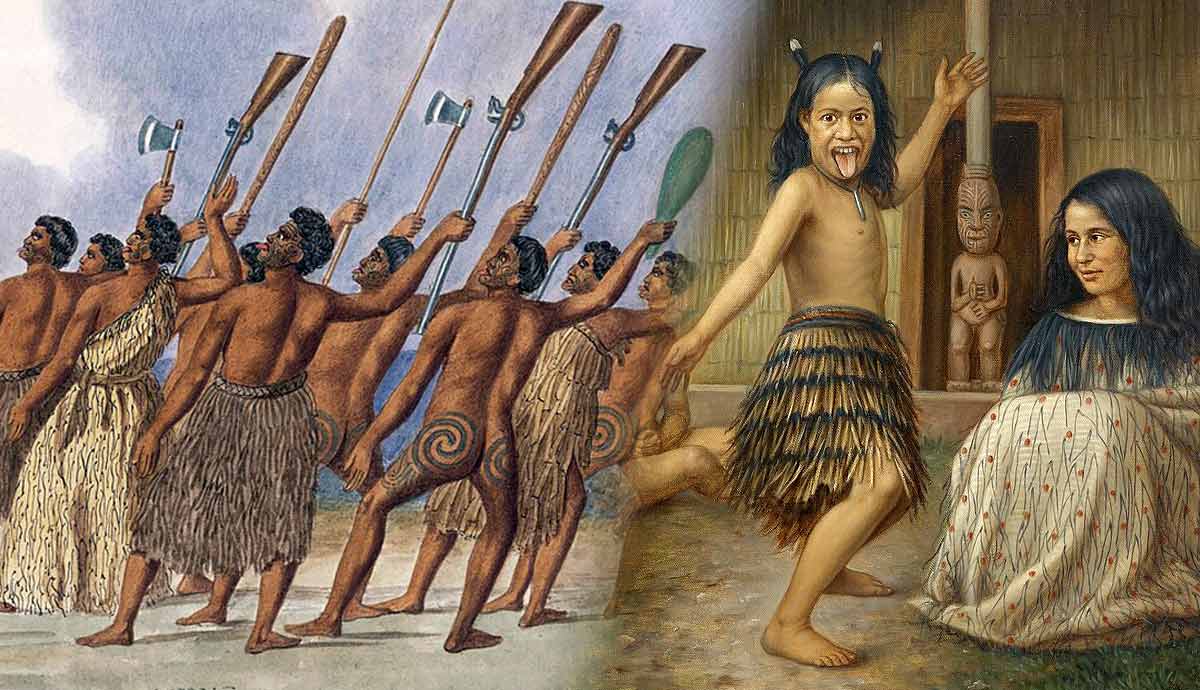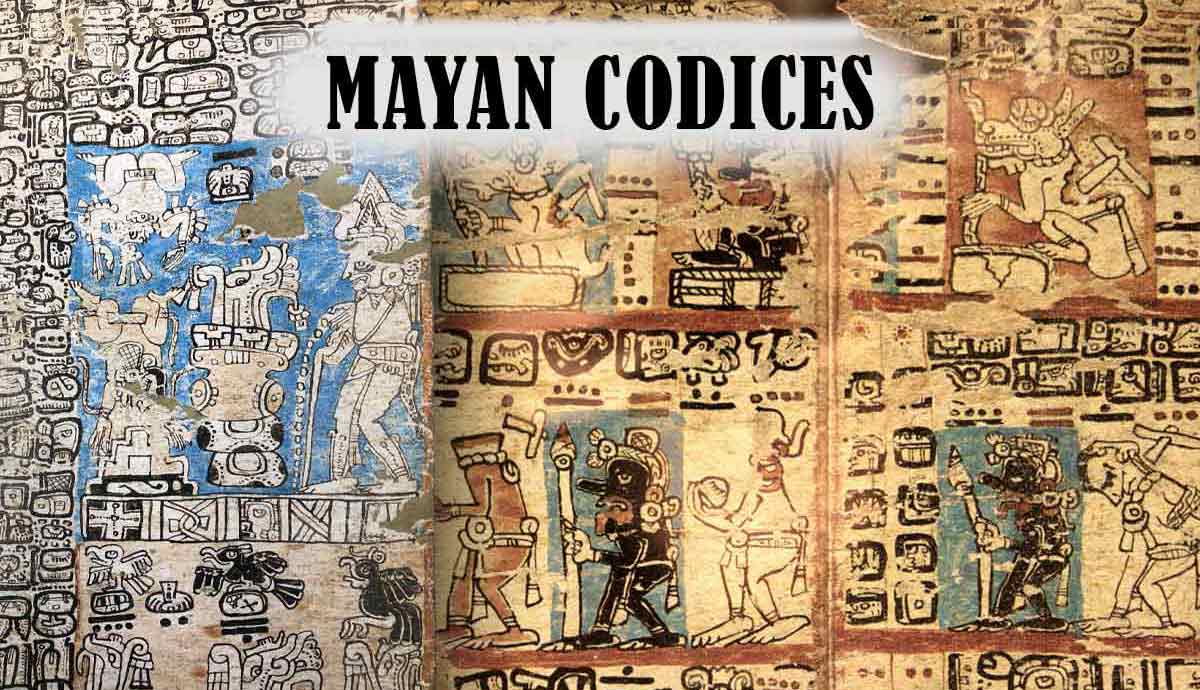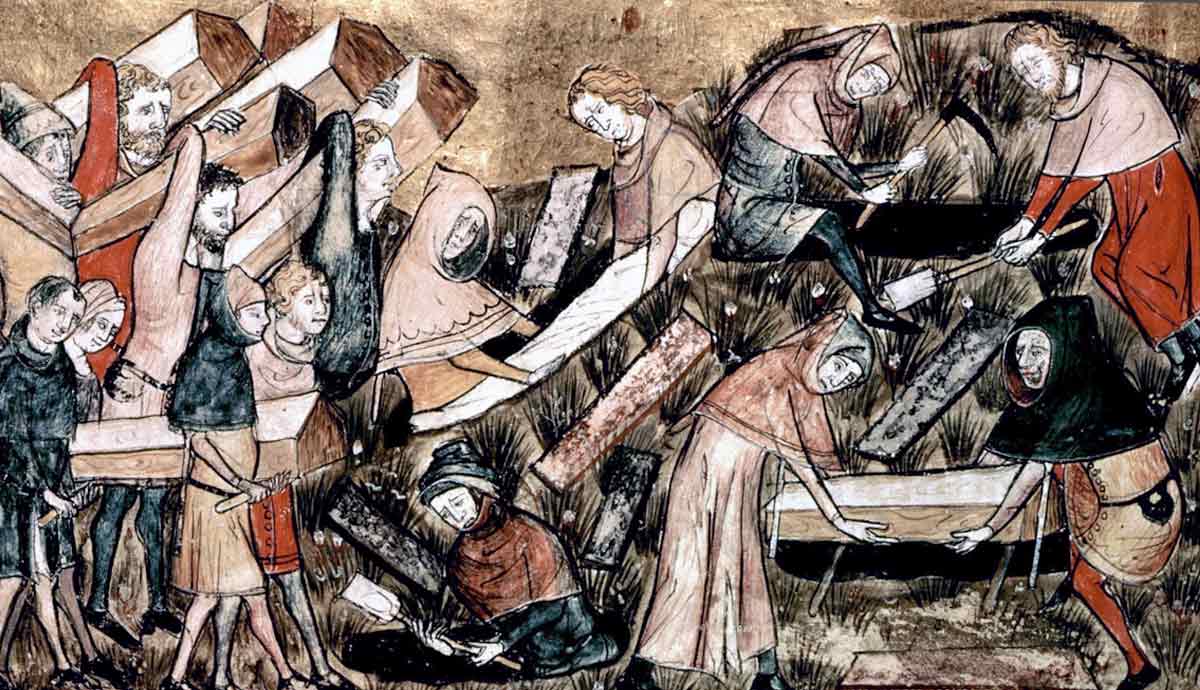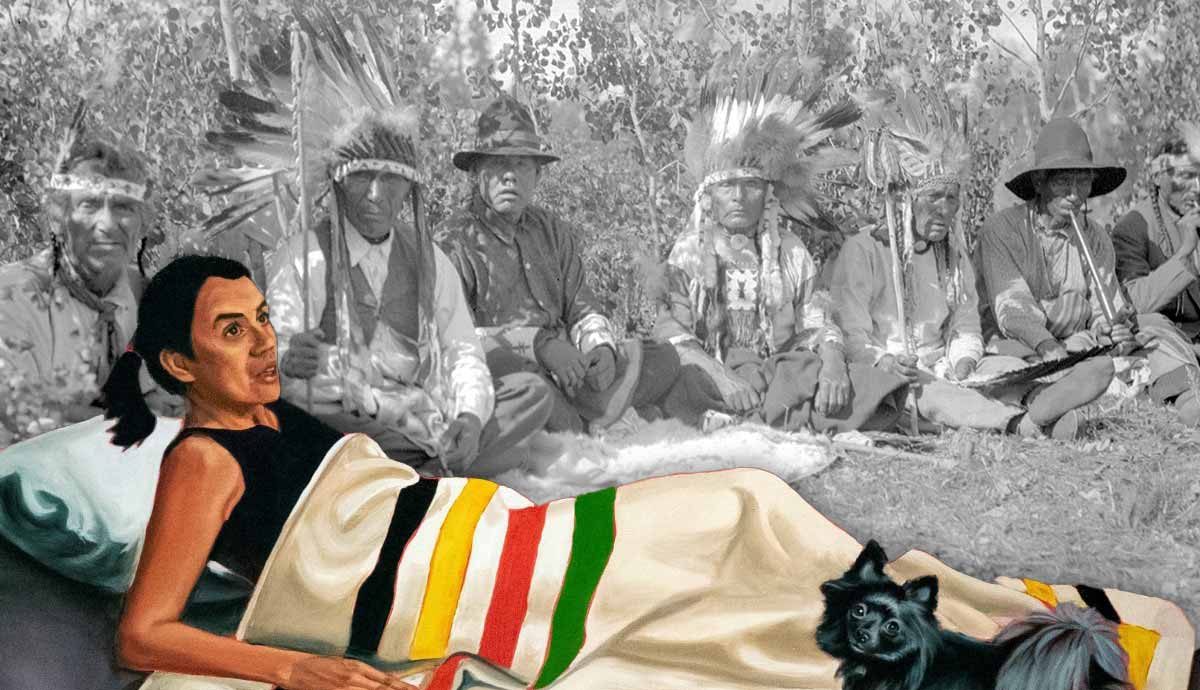
Canada was built by men and women of mixed ancestry, men and women who were métis, that is, of “mixed heritage.” However, not all métis (lowercase) can be considered Métis (spelled with the uppercase “M”). Today it is widely accepted that only individuals with Cree and French-Canadian origins and a direct family connection to the Red River Settlement, near Winnipeg, in present-day Manitoba, belong to the Métis Nation. As we will explore in this article, Métis culture derives its strength from the blending of elements from Indigenous and European traditions and spirituality.
The Language(s) of the Métis

The official language of the Métis Nation is called Michif. It is a relatively recent language, dating to the late 18th century when it originated among Métis bison hunters and traders in present-day Manitoba. It is also a hybrid language, combining verb structures, syntax, and personal pronouns of the Plains Cree dialect with French (and sometimes English) nouns, articles, numerals, and adjectives. Occasionally, Michif also features English terms and words borrowed from Saulteaux, the Algonquian language spoken by the Plains Ojibway (who call it Nahkawininiwak in their language).
The Métis’ ability to develop a sophisticated and completely new language suggests that early Métis communities were at least bilingual, mastering Cree and French. In addition to Michif, most of them also spoke settler languages (particularly English and French) and various First Nations languages, such as Cree, Dene, and Saulteaux.

Indeed, the older Métis generations still refer to their language as Cree Michif or Métis Cree and identify themselves as Michif. Unfortunately, the elders are often the only ones who can still fluently speak Michif. For decades, Métis men and women were ridiculed for speaking their language, often dismissed as “bad French” by Francophone and Anglophone Canadians alike. In residential schools, missionaries and teachers forbade Métis children from speaking the language of their parents.
Well into the 20th century, non-Indigenous Canadians continued to view Métis as either “rebels” or “squatters.” As a result, to better fit into “white” society, particularly in cities like Winnipeg and Calgary, many Métis hid their identity and refused to speak Michif. Although Michif is an endangered language, it continues to be spoken in all three Prairie provinces and across the border in Montana and North Dakota.

The Michif spoken in the Turtle Mountains of northern North Dakota is known as “Turtle Mountain Chippewa-Cree” and has its own spelling, although Michif has no standardized spelling system. While Michif is the major language spoken among Métis communities across Manitoba (particularly around the Qu’Appelle and Assiniboine rivers) and in Saskatchewan, along the Qu’Appelle Valley, it is not the only one.
The Métis communities of the village of Île-à-la Crosse in northern Saskatchewan, for instance, speak French Cree, which is radically different from Michif, despite their common origins. Bungi, a mixture of Cree, Ojibwe, English, Gaelic, and (a few) French words was traditionally spoken in the Red River valley north of Winnipeg by Métis communities with Scottish and Ojibwe ancestry.
Music and Art

The Indigenous Peoples Atlas of Canada describes the Métis using these terms: “Canada has a founding people who once traversed North America’s interior in Red River carts, hunted bison with military precision, danced and jigged to spirited fiddle rhythms, wore brightly adorned embroidered clothing, spoke one of humanity’s unique languages, prayed to Li Bon Jeu/Kitchi Manitou and to their patron saint, St. Joseph, and even had their own werewolf. These people were the Métis.”
For centuries, Métis Elders (known in Michif as “lii vyeu,” “the old people”) have served as a bridge between the present, the past, and the future, as the depositaries of Métis stories, traditions, religious practices, as well as, of course, songs and dancing styles. Since the days of the fur trade, Métis men, women, and children have danced to the tune of French-Canadian, Scottish, and Indigenous rhythms, crafting new dancing styles that blended step-dancing, jig, and quadrille steps.

The first recorded Métis song is the so-called “Red River Jig,” a variation of the Scottish tune “Big John McNeil” by Peter Milne. The accompanying dance is known in Michif as “oayache mannin” and it powerfully combines European and French-Canadian traditional dance styles such as reels, jigs, stomps, and quadrilles with typical Plains Indian dance steps.
Historically, every year Métis would attend the so-called Red River Ball, where fiddle players, callers, jiggers and square dancers would play and sing and dance well into the night. Even Louis Riel (1844 -1885), the leader of the 1885 Northwest Resistance, was a songwriter. He wrote La Métisse (The Métis Girl) to honor the role of Métis women during the Red River Resistance, and C’est au Champ de Bataille (The Battlefield), a tune that reflects on the price paid by soldiers in a time of war.

Métis were not only talented fiddle players and storytellers but also excellent embroidery artisans known among Europeans and Indigenous people alike for their colorful floral beadworks. Unsurprisingly, the Cree and Dakota often referred to the Métis as the “Flower Beadwork People.” Métis beadwork patterns adorn tablecloths, wall pockets, coats, belts, bags, mocassins, and mittens.
Many Métis girls raised in Roman Catholic missions became skilled artists, blending First Nations beadwork with European designs from French-Canadian nuns. Métis floral beadworks continue to be one of the most distinctive symbols of Métis culture, a tradition that persists today in the works of many contemporary Métis visual artists, such as Christi Belcourt (apihtâwikosisâniskwêw / mânitow sâkahikanihk) and Lisa Shepherd.
Red River Carts

The Michif word for Red River cart is “an charet,” or “aen wagon.” During the fur trade era, two-wheeled Red River carts were the tenets of Métis life on the Prairies. They usually had one two-meter-long box (6.5 feet), about 85 centimeters (33 inches) in width, and two massive wheels, from one to two meters (6.5 feet) in diameter.
The Red River carts were complex vehicles made from various types of wood. The wagons’ hubs, for instance, were made from elm, and each piece was tied to the others by pieces of sinew or robe. The wheels’ rims were made from oak or white ash trees, while the axle was usually carved from hard maple. The wooden axles of the cart could not be lubricated, as the grease would attract dust and slow the vehicle down. Consequently, the rubbing of wood and leather would produce an ear-piercing squealing noise that could be heard for miles.

The Métis used to wrap their wagon wheels with shaganappi, cords of rawhide (often of bison), to form a sort of tire that would stabilize the cart on the rough terrain of the Prairies. Linguists suggest that the word shaganappi, translated as “flayed cord” or “rawhide thong,” was borrowed from the Algonquian. Other linguists maintain that shaganappi is a Métis corruption of the Cree word pesaganappi (or shâkanâpiy), which means “shred in a circle”—which is extremely likely, given the direct connection between Cree and Métis and their languages. Today, there is a neighborhood in Calgary called Shaganappi.
Trains of Red River carts used to tie together Métis communities in and around the Red River Valley, at the confluence of the Assiniboine and Red Rivers in what is now Manitoba, where Métis culture as we know it today originated.

An average Red River cart could carry between 300 and 450 kilograms (31-55 stone) of freight and, unlike other First Nations wagons, it could be pulled by one single horse, pony, or ox. Métis fur traders crisscrossed the Prairies on their Red River carts, transporting furs, buffalo hides, decorated tanned skin clothes, as well as sugar, tobacco, tea, and alcohol, from one outpost to another, from the Red River Settlement to Batoche, Saskatchewan, and St. Paul, Minnesota. Red River carts could be transformed into sleighs and floating vessels in winter. During their annual bison hunts, carts were turned into makeshift homes, colorfully decorated with floral embroideries.
Spirituality

The complexity of Métis spirituality mirrors the complexity of Métis history. Because Métis communities across Canada are (and have always been) extremely varied, it is impossible to isolate a single Métis spiritual tradition. Historically, most Métis were Catholic. They used to practice a form of folk Catholicism that blended elements of Cree and Plains religions rooted in Algonquian spiritualism.
Central to the Métis’ syncretistic religion was the contrast between good and evil. Indigenous evil spirits tended to merge with the figure of Satan. Similarly, the Indigenous creator known as Kitchi Manitou (the name translates as “Great Spirit” in various Algonquian languages) converged with the Catholic God to the point that even today many Ojibway consider God and Manitou two interchangeable figures.

Originally a genderless figure, Kitchi Manitou (also known as Gitche Manitou) created the world as we know it. Abstract, benevolent, and superior to the daily lives and sorrows of human beings, he rarely interacted with humans. His name is sometimes translated as the “Giver of Life” and, among the Lakota, the “Great Mystery.”
In the early 19th century, many Métis men and women became missionaries and nuns. They taught in schools, administered the gospel at fur trade posts, and translated the gospel and other religious works into Cree. Métis parishioners took part in pilgrimages at St. Laurent de Granding, near Duck Lake, in Saskatchewan, and at Lac Ste. Anne in Alberta. Within the Catholic community, the veneration of the Virgin Mary and the saints is central to Métis spirituality.

Respect for the deceased is also important, as their souls are believed to reside within the dancing movements of the northern lights, known as “lii chiraan” in Michif. It is considered disrespectful (and dangerous) to whistle at the northern lights, as the dead may interpret it as a sign of disrespect and punish the whistler by “taking” them away. Today, some Métis are also Protestants, others are Mormons, some have become Jehovah’s Witnesses, while others have embraced the beliefs of New Age revitalization movements.
In Between Two Worlds

For better or worse, the Métis have always lived in between two worlds. During the colonial era, they often served as intermediaries between First Nations and settlers. Some of them worked as guides, scouts, and hunters accompanying settlers and explorers on expeditions westward, while others served as translators during the drafting and signing of the Numbered Treaties on the Prairies and in northwest Ontario.
When they petitioned the government to have their property rights recognized and protected, the Métis were symbolically bridging the two groups, First Nations and Europeans. Property rights, in fact, fell within the scope of the rights of the settlers, not the Indigenous. In the 18th and 19th centuries, in Canada as well as in Australia, settler societies maintained the belief that First Nations had no rights to their lands because they did not “properly” exploit them.

The Métis, who could move (relatively) easily between the two groups and had an insider understanding of both cultures, were quick to take advantage of different economic opportunities. They crisscrossed the Plains on their noisy Red River carts transporting furs for settlers long before the completion of the Canadian Pacific Railway (or Canadian Pacific) in 1885. They also picked Seneca root, a perennial plant growing on the Plains, for pharmaceutical companies and collected bison bones (which could be turned into excellent natural fertilizer when pulverized and mixed with nitrates and potash) and sold them to fertilizer companies. Bison hooves and horns were in high demand for paints and adhesives.

For decades, many men and women chose to hide their Métis identity and “pass” as white. Today, however, thousands of Métis artists, filmmakers, writers, and entrepreneurs have succeeded in bringing Métis culture and history to the forefront of national attention. One example is actress Tantoo Cardinal, who is of Métis and Cree descent and has collaborated with directors such as Kevin Costner and Martin Scorsese. In the 1970s, author, playwright, and Métis Elder Maria Campbell shared her experience as a Métis woman in her memoir Halfbreed (1973).
As of 2021, the Métis population in Canada is one of the fastest-growing demographics, with a 6.3% increase in population between 2016 and 2021. With their distinct fusion of Indigenous and European traditions and spirituality, the Métis continue to make a valuable contribution to the diversity of Canadian society.
